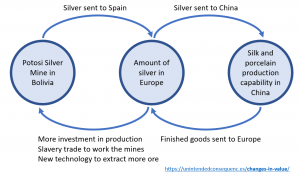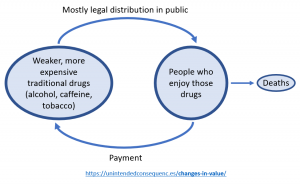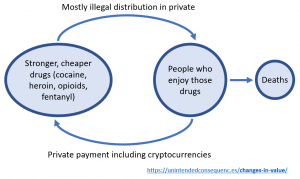When something changes in financial value quickly, unintended consequences abound. When this change happens at scale, affecting many people, the consequences are even more extreme. These changes impact supply and demand and social change around the world.
Let’s look at some examples of value change causing havoc. This week I’m intentionally (well, almost entirely) not writing about the topic you can’t escape.
Sudden changes in value are casually thought of as uncommon, but happen throughout history. When I say “sudden” I mean that over a period of years you might find very different values put on similar items.
Sometimes it’s the system that’s behind this.
Discovery, extraction, trade
Global silver production doubled in the 1500s following the Spanish discovery of a mountain of high-quality silver ore in Potosi, Bolivia (at the time part of Spain’s colony of Peru).
Potosi is a rare city at an altitude of 2.5 miles. The city was built to serve the silver mine. The business of mining made Potosi the second largest city in the world in the 1600s, The amount of precious metals extracted spawned the phrase “vale un Potosí”, or “to be worth a Potosi.”
In Potosi’s case, the local presence of silver ore and a new entrant colonial power that valued silver, created a market for production. That also created some of the cruelest slave labor to date as the Spanish colonists forced local people to work in the mines. The colonists also created free worker options and imported slaves to work in the silver mines. Slaves and workers suffered pneumonia and poisoning from mercury (used in mining).
That extraction of silver led to other changes in value. The silk and porcelain trade centered around using Spanish silver to pay for Chinese goods. Arbitrage for silver was so extreme (with the difficulty of distance) that it was worth double in China during the Ming Dynasty, when Potosi’s production started to peak. While China had paper money centuries earlier, the fiat became inflated and suffered from counterfeiting. Importing silver in exchange for Chinese porcelain and silk was the solution.

The money to be made in this system was so great, that it led to many terrible moral choices. Had there been no market for silver or a much less productive silver mine, there would have been less suffering.
Pandemic social disruption
I include the following story about speculation in tulips partly to consider what could happen in similar times, as I wrote earlier. From Tulipmania, by Anne Goldgar (p 257-8):
“Yet with such major and protracted mortality there will have been many repercussions. One of these was certainly financial. Death meant inheritance, and with so many people dying, estates, which were often divided up among many members of families, would have been quickly providing unexpected capital to potential buyers of tulips. One example is Geertruyt Schoudt, who was persuaded… to buy a pound of Switsers [a type of tulip] precisely because she was expecting to receive part of the estate of her late brother-in-law…”
“Large-scale mortality from plague caused social upheaval; the redistribution of wealth did the same.”

Things would have to get very bad to see a similar impact today. I don’t see this happening, except maybe in small hard-hit locations. Well, maybe things could be similar to the Dutch case after all…
Drugs old and new
Drugs have historically been expensive and weak compared to options today.
That is, the effect from a drug (I’m including long-time stimulants and depressants like alcohol, caffeine, and tobacco too) used to cost more per dose. But I’ll take that as related to how effectively people grew grapes and produced wine, how effectively they grew or imported tea and coffee, and the same for tobacco.
When it came to gross overuse, those who died from drugs mostly died slowly, over years. I’ll count alcohol poisoning deaths as something that people work up to, rather than do when they have barely any experience drinking. Same for smoking tobacco. It takes years for the impact of lung, mouth, or other cancers to take a life.

Drugs started to change in a couple of ways.
Drugs became more powerful, but for a while stayed expensive. Refined cocaine and heroin, for example had a much stronger effect but also a higher price than the traditional alternatives.
Then more recently drugs became both cheap and powerful. See examples especially from the opioid crisis and fentanyl.
There are other impacts from drug changes in value. Opioids and their addiction-based business models led to deaths and therefore greater supply of organs for transplant.

Things will change when the drugs are so small per dose and cheap that they can be sent in the mail and paid for by cryptocurrencies.
Consider
- Where is there future potential for changes in value?
- Is there a system that drives the change in value?
- How does the system impact qualities we might feel to be unchanging, like morality?